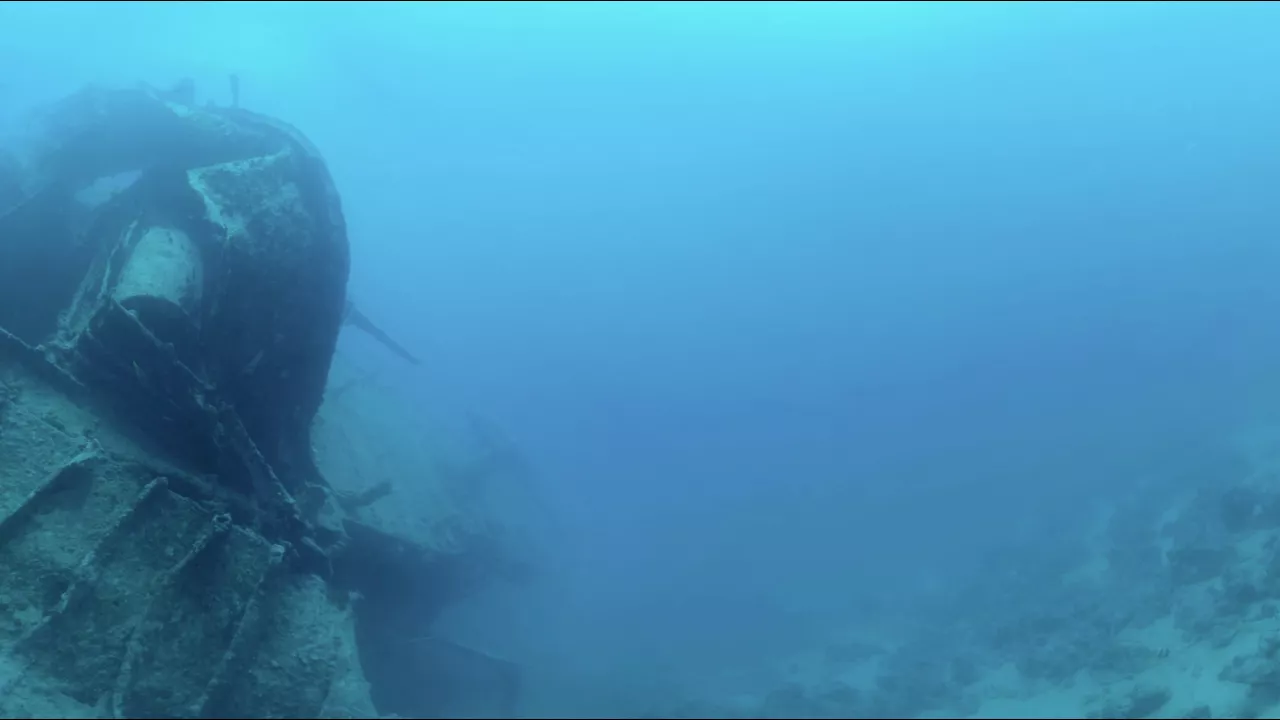From North to South
In the early 1980s I was just getting started as a dive photojournalist, working from my home base in Key Largo, Florida. The dive magazines of the day were happy to assign me articles on the Florida Keys, and they didn’t seem to mind sending me to some reasonably nearby dive destinations. My beat evolved into the Keys, the Bahamas and the Caymans. Fly, shoot, write, repeat became the routine, with the destinations about an hour flight from Miami.
The pattern was entirely satisfactory until I saw a Sport Diver magazine featuring a Red Sea cover story by Rick Frehsee. His images of vast crimson soft corals, translucent azure waters, and exotic clownfish and lionfish decorating the pristine coral reefs immediately shaped my new fantasy dive destination. That is where I wanted to go — had to go — to take underwater photos. None of my editorial clients planned to send me on an expensive dive holiday to the Red Sea, however, and I didn’t have enough money to get there on my own.
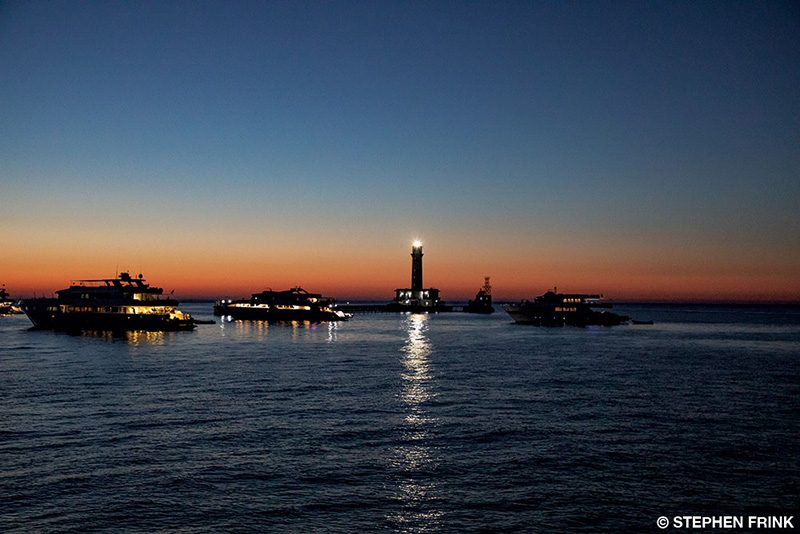
For the first time in my career I took a big chance and chartered a liveaboard. If I managed to get enough clients to go along with me, maybe I could make enough money to pay for my airfare and the dive trip. If I didn’t sell all the spots, however, I could lose thousands of dollars I didn’t have. It was a huge risk for me at the time, but fortunately for my subsequent career in dive travel I managed to sell enough spots on the Sunboat to dive the Red Sea, my first-ever exotic dive destination.
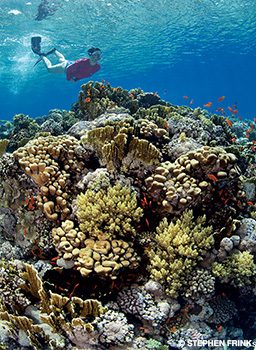
In the intervening decades the Sunboat fell to disrepair and is now a wreck dive off Eilat, Israel, and my experience in international dive travel has expanded considerably. The Red Sea remains one of my favorite dive destinations in the world. The waters are still beautifully blue, the reefs and wrecks are still lush and awe-inspiring, and although I regrettably don’t need to travel so far to encounter lionfish these days, there are plenty of rare and wonderful fish species typical of and endemic to the Red Sea.
Geography makes the Red Sea special. A 1,400-mile extension of the Great Rift Valley in Africa, the Red Sea is bordered by Jordan and Saudi Arabia to the east, Egypt to the northwest (where most of the diving is done), Sudan and Yemen to the southwest, and Djibouti, Eritrea and Somalia to the far south. These arid countries provide very little freshwater runoff (less than 3 inches per year) to degrade visibility, and much of the shoreline is uninhabited. Sharm el-Sheikh and Hurghada on the Egyptian Red Sea are well-developed holiday destinations, with thousands of hotel rooms available. While driving down the coast from Hurghada to Port Ghalib we saw very little development along the seashore and consequently little opportunity for ocean pollution from construction or habitation.
In May 2019 I revisited that business plan from the early 1980s by chartering a liveaboard and organizing a photo tour. This time I chartered two different boats: one to dive the northern Red Sea and another for the south, keeping the diving and traveling within Egypt. We flew in and out of Hurghada, departing directly from a marina there to dive the north and later driving three hours by bus to commence the southern itinerary from Port Ghalib.
Northern Red Sea
Beginning our tour of the northern Red Sea, we left the marina in Hurghada for a short steam to Poseidon Reef for the morning’s checkout dive. These initial dives are traditionally underwhelming in most dive destinations, usually designed for guests to adjust their buoyancy. Remembering my first dive there in 1982, when I saw my first clownfish and lionfish within the first five minutes, I knew to be prepared for whatever might swim by in the Red Sea.
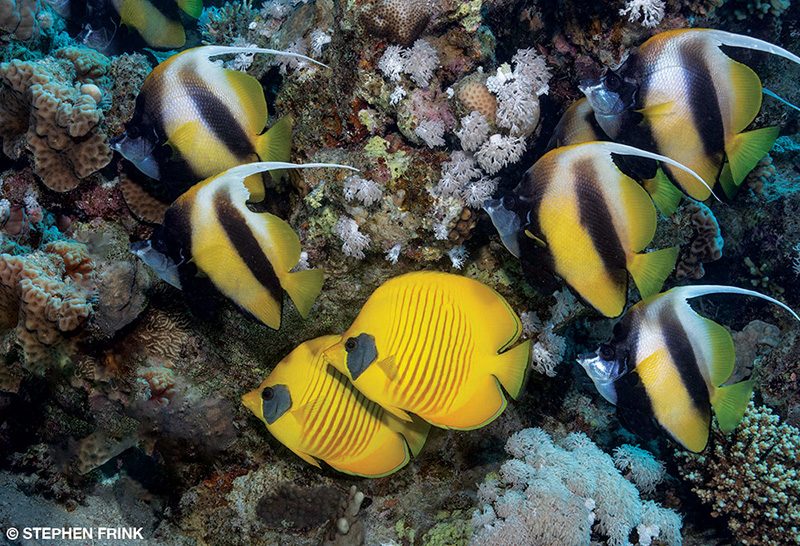
On this dive the endemic bluecheek butterflyfish (Chaetodon semilarvatus) was unsurprisingly in residence, schooling alongside the equally common Red Sea bannerfish (Heniochus intermedius). While this dive didn’t offer the rich soft coral we would encounter on subsequent dives, the marine life was diverse and approachable, making for a productive checkout dive.
The northern Red Sea offers several interesting historical shipwrecks, accentuating the rich maritime history of the region and the number of shallow pinnacles that rise nearly to the surface and disrupt navigation. Sha’ab Abu Nuhas Reef, north of Shadwan Island in the Shadwan Channel, is notable for the five cargo ships wrecked along its northern sloping reef. Our next dive was to the British steamship Carnatic, which sunk here in 1869 and now rests at about 70 feet. Its cargo of gold, cotton and wine is long gone, but broken wine bottles are still evident in the holds. The iconic stern view creates a nice photo opportunity from a distance, and a closer view along the exterior of this 300-foot wreck reveals abundant hard and soft corals. The glassy sweepers schooling inside the wreck make for a nice image, using as a background silhouette the iron ribs that once supported the wooden flooring.
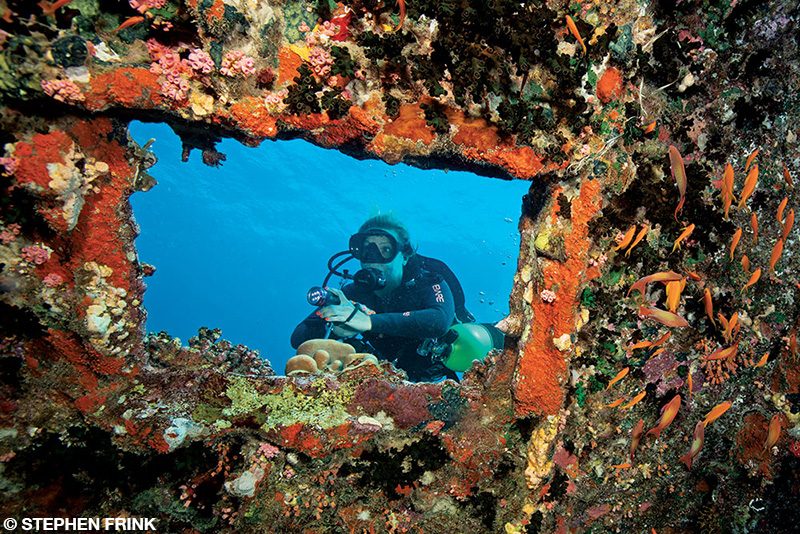
The Chrisoula K, also known as the “Tile Wreck,” sank in 1981 with a cargo of granite floor tiles. This 322-foot Greek freighter hit the reef and sank upright, with the stern at a depth of 92 feet and the bow at 13 feet. Plenty of swim-throughs and a superstructure draped in soft corals make this a particularly interesting wreck.
Another well-known Abu Nuhas shipwreck is the Giannis D. This 326-foot Greek cargo ship sank in 1983, with the bow sitting at 33 feet and the stern at 80 feet, comfortably within recreational diving range. The bow and stern remain mostly intact, but the midship has collapsed. On the return to our boat we encountered a pod of semiresident bottlenose dolphins. The water here was a cool 73°F the week of our visit, making our deep breath-hold dives in 5 mm wetsuits difficult, but the dolphins were engaging.
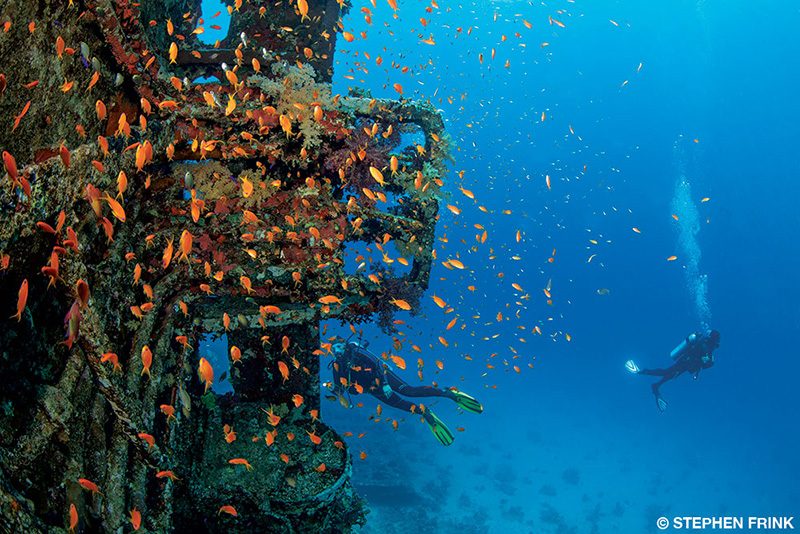
The best-known wreck dive in the Red Sea, the 420-foot armed freighter SS Thistlegorm, is found off Sha’ab Ali. Its final voyage commenced in June 1941 bound from Glasgow, Scotland, for Alexandria, Egypt, with supplies for British troops in World War II, including tanks, armored vehicles, aircraft, trucks and the iconic BSA motorcycles still found in the holds. Sitting upright from 52 to about 105 feet, the wreck shows evidence of the German bomb that hit it along the port side and the munitions that exploded within, which caused the most catastrophic damage. Holds No. 1 and No. 2 contain Enfield rifles, and Hold No. 3 has munitions crates and grenades. An upside-down Bren Carrier tank as well as a steam locomotive engine lie on the port seafloor, proof of the massive forces that destroyed the ship.
The ship sank Oct. 6, 1941. Jacques Cousteau rediscovered the wreck in 1955 after hearing about a shipwreck in the region from local fishermen. He documented his dives in a February 1956 issue of National Geographic and in his book The Living Sea, and then the wreck was largely forgotten. In the early 1990s Sharm el-Sheikh began evolving as a dive destination, and recreational scuba divers started to visit the Thistlegorm. Accessible by both liveaboards and day boats, the Thistlegorm now is one of the most heavily dived shipwrecks in the world. By awaking over the wreck at 5 a.m., my group was fortunate enough to have the entire wreck to ourselves, with the hordes of other divers not appearing until we were on our way up the mooring line.
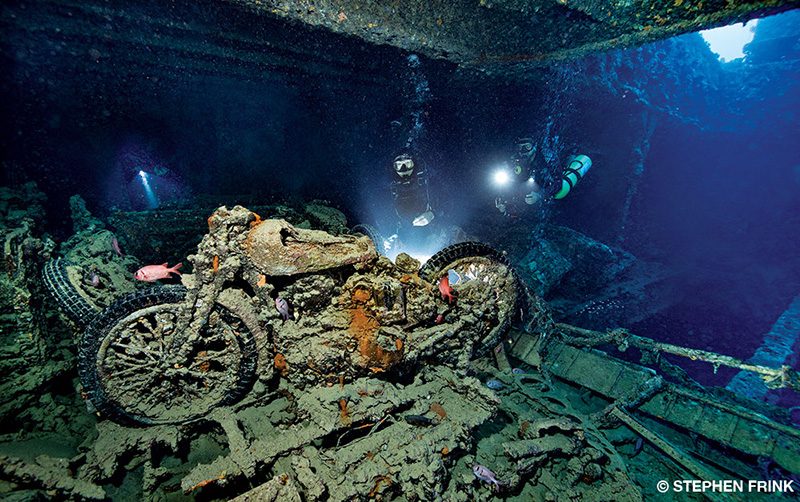
At the very tip of the Sinai Peninsula is one of the world’s most famous dive sites: Ras Mohammed. We began our navigation at the crimson-mantled clownfish congregation known as Anemone City and then let the light current propel us along the soft-coral-draped vertical walls to Shark Reef, where we paused to photograph the large school of resident batfish. The dive guides opined that from July to September the schooling fish action at Ras Mohammed is exponentially better. We finished our dive above the detritus from the wreck of the Jolanda. Having struck the reef on April 1, 1980, it was still a visible shipwreck when I first dived the Red Sea. In 1985, however, storm-driven waves dropped it over the wall where it now rests at 530 feet. Broken porcelain toilet fixtures lying between 50 and 80 feet are about all that remain of the ship’s cargo today.
The Strait of Tiran, located in the channel separating the Sinai mainland and Tiran Island, encompasses four distinct and notable reefs: Gordon, Thomas, Woodhouse and Jackson. The sight of hundreds (possibly thousands) of anthias flitting about pristine lettuce corals and a visit from a friendly hawksbill turtle were the best presents I could imagine for a morning birthday dive at Jackson Reef. There were no signs of broken coral and no indication of bleaching or coral disease. People who dive here all the time may notice differences from year to year, but my recollections from 35 years ago aren’t much different from my observations this day, unlike the condition of many reefs in my travels.

Later that day we motored to Gubal Island and were briefed on the dive at the Barge. Little remains of the unknown vessel, but it holds a fascinating diversity of marine life, including frogfish, mouthbrooding cardinalfish, crocodilefish, stonefish, Arabian angelfish and an octopus that was indifferent to how near we approached or how often our strobes fired. It was such an easy dive at about 45 feet that the boat created an open-deck policy, allowing us to come and go at our leisure; most of us made three dives that day as well as a night dive.
The dive tender transported those who wished to try something new to the wreck of the Ulysses. The 312-foot steam-and-sail ship was traveling from London to Penang, China, when it struck the reef on the east side of Small Gubal Island in August 1887. The crew offloaded much of the cargo while the ship was still hard aground on the reef top but couldn’t remove large drums of cable; the site is sometimes referred to as the “Cable Wreck.” The wreck rests on its port side on a slope between 13 and 92 feet of water; the masts, canted to the seafloor, are nicely decorated with soft coral. The deck planking is long gone, but the iron ribs are profusely populated with sponge and soft coral. Glassfish like the recesses of the holds and consistently school there.
Southern Red Sea
While the diving we enjoyed in the north would be enough for any dive holiday, we greedily booked another liveaboard to the south for this trip. These distinctly different itineraries are far enough apart to even have a change in water temperature. The south was several degrees warmer than the north, which usually isn’t significant in the summer when it is warm everywhere, but in late spring we found the difference between 73°F and 77°F both noticeable and welcome.
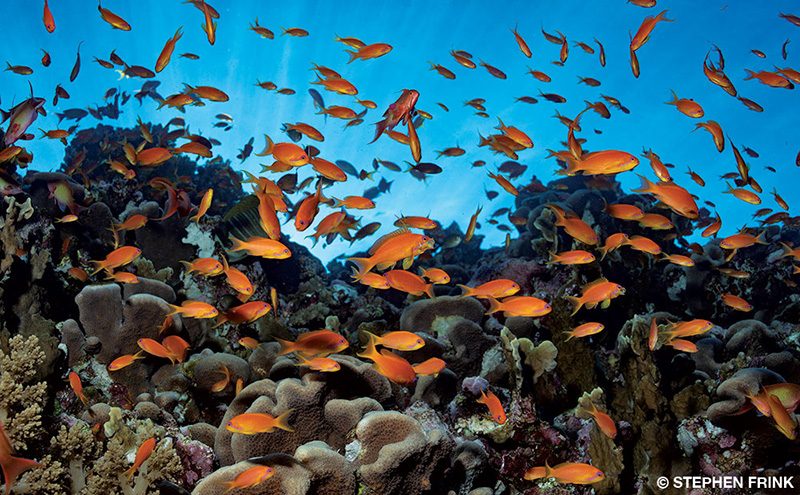
After traveling by bus from Hurghada to Port Ghalib, we had a three-hour cruise to Elphinstone Reef, where we found a long seamount running north to south, rising from the depths to just below the surface. Morning dives are normally along the eastern flank with its nearly vertical walls, abundant soft coral and concentrations of anthias. Large schools of jack and spadefish are common. The afternoon light illuminates the western side, which is not as vertical but attracts nice groups of butterflyfish in the many fissures along the reef face. At the south end is a saddle in 80 to 90 feet of water that is a productive observation platform for the sharks that patrol the deeper waters to seaward. Because of the possible currents and the open ocean surrounding the reef, night dives are not permitted.
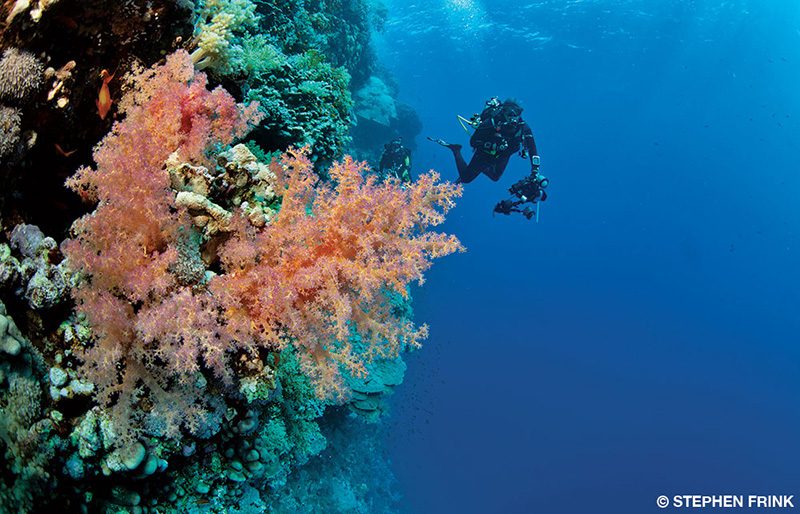
Daedalus Reef, one of the more iconic dive sites in the south, is marked by a large lighthouse built in 1863 (and rebuilt in 1931) sitting atop an artificial island dotting the 1,300-foot-long by 330-foot-wide coral reef. Most of the diving is along the eastern face in the morning light and along the western wall when it is better lit in the afternoon. Similar to Elphinstone, currents run north to south. The east is better for massive hard-coral structures so large they must be centuries old and for good shark encounters, including hammerheads. The west has better soft corals, but the big attraction is another Anemone City. It is a smaller cluster than the one at Ras Mohammed, but it’s impressive nonetheless. While there are 30 species of clownfish worldwide, here the Red Sea clownfish (Amphiprion bicinctus) is the most common. Host anemones often have red mantles, which when curled up provide a photogenic wide-angle opportunity.
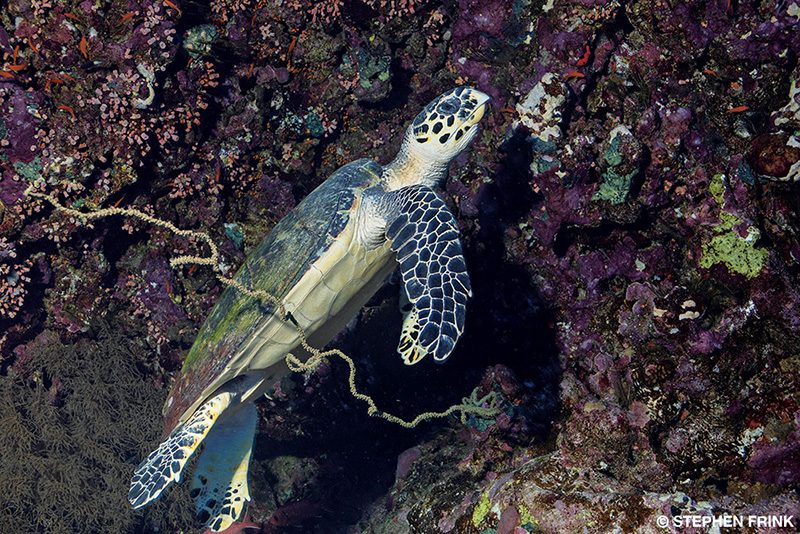
Southern dive itineraries often include the Brothers Islands. Due to attacks on divers by some oceanic whitetip sharks in the area, the Egyptian government shut down diving for a few months to monitor the behavior; the islands are now open to diving again, only with overnight mooring no longer allowed. The Brothers are 125 miles south of Ras Mohammed and 40 miles east of Port Ghalib, so long-range liveaboards following northern or southern itineraries could conceivably reach them, but boats from the south are more likely to visit.
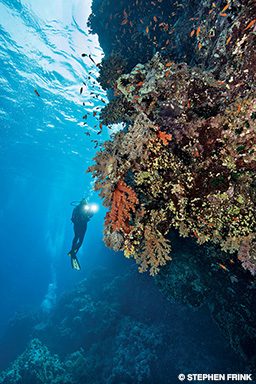
The islands are two ancient volcanic peaks just two-thirds of a mile apart. Little Brother is rich with soft corals — a testament to the swift currents that often bathe these islands — and large schools of crimson moontail bullseyes. Big Brother has an operational lighthouse the British built in 1883 but is best known for the two shipwrecks at the northern end. The Numidia, which sank in July 1901 on its second voyage, is a brilliant wreck for divers, although the currents on that corner of the island can sometimes be quite extreme. This 450-foot ship rests on a precipitous reef slope with the bow at only 26 feet and the stern at approximately 260 feet. Just to the southwest of the Numidia lies the Aida, which sank in 1957 after striking the island in heavy seas and now rests in 80 to 200 feet of water. With so little safe no-decompression time on the Aida, most recreational wreck diving off Big Brother is on the Numidia. I’ve seen only a portion of the Numidia due to its sloping depth, but an active technical dive community in the Red Sea regularly dives both wrecks.
Rocky and Zabarghad Islands, only 25 miles north of the Sudanese border, are as far south as we cruised on this trip, although some itineraries travel another 12 miles southwest to dive the shallow cave system of St. John’s Reef. We spent the morning along Rocky Island with its huge sea fans and resident longnose hawkfish, and the shallow coral garden at Zabarghad occupied us for the afternoon.
The highlight of our southern itinerary was snorkeling with spinner dolphins at Dolphin House. A horseshoe-shaped reef at Sataya is home to a large population of spinners. They come into the shallow bay during the day to rest, but there isn’t much rest for them at midday when the day boats and liveaboards congregate there. Fortunately, the area is a couple of hours south of the small town of Hamata for the day-trippers, and liveaboards don’t spend much time there before moving on to their afternoon dives. I had my best encounters when dropped off ahead of the direction the pod was traveling. Sometimes they veered off, and I saw nothing; usually I would have some near but fleeting flybys. Even by the spotted-dolphin standards I’ve come to enjoy in the Bahamas, these are excellent opportunities in typically very clear water.
How to Dive It
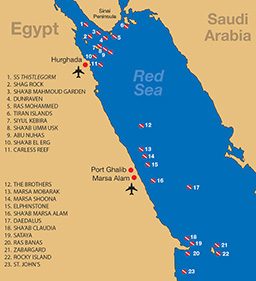
Getting There: Both Hurghada and Sharm el-Sheikh are popular vacation destinations for Europeans, and modern international airports are in both cities. It is easy to connect via Cairo or major European gateways. There are direct commercial and charter flights to Marsa Alam from Cairo and Europe, but flights are less frequent than those to Hurghada. It’s a three-hour bus ride from Hurghada to Port Ghalib. Arrive on time for your liveaboard departure, because security regulations prohibit boats from returning to port to pick up tardy passengers or delayed baggage.
Conditions: The water may cool to 68°F in the winter but may be as warm as 85°F in the summer. Winter winds can make some of the crossings to the offshore islands difficult. Some sites are easy dives, but strong currents can complicate others. Most dives are multilevel, offering the possibility to work up a wall or a pinnacle to offgas safely. Dive operators in the Red Sea tend to enforce the buddy system, and divers should be adept at deploying a subsurface marker buoy because of the heavy traffic from dive tenders around the more popular sites. Modern hyperbaric chamber facilities are in Hurghada, Sharm el-Sheikh and elsewhere in Egypt.
Marine Parks: There is no single authority like you might experience in other destinations, but small organizations under the authority of the Egyptian Environmental Affairs Agency protect and enforce user fees in a few specific areas: Ras Mohammed, the Giftun Islands, the Brothers Islands, Daedalus Reef, Zabarghad and Rocky Islands, and the St. John’s Reef system.
New Diving Regulations: The Egyptian government has recently begun enforcing regulations that require all dive operations to obtain a dive medical history form before allowing anybody to participate in recreational diving activities. The universal Recreational Scuba Training Council (RSTC) form is acceptable documentation to indicate fitness to dive.
Egyptian Antiquities: If your holiday time permits, take a few days to visit the iconic antiquities unique to Egypt: the Pyramids of Giza and the nearby Sphinx. The Museum of Egyptian Antiquities in Cairo, established in 1902, houses many of the most important artifacts of ancient Egyptian history, including the instantly identifiable burial mask of Tutankhamun. A weeklong Nile River cruise takes you from Luxor to Aswan, visiting the Temple of Karnak, the Tomb of Queen Nefertari, the Luxor Temple and the Valley of the Kings, which houses the tombs of Tutankhamun and Ramses VI. The history, combined with the leisurely pace of a five-star Nile River boat, is a wonderful complement to a Red Sea dive holiday.
Explore More
Watch a 360-degree video tour of the SS Thistlegorm wreck, made as part of the Thistlegorm Project initiative. Learn more at https://thethistlegormproject.com.
© Alert Diver — Q3 Summer 2019
